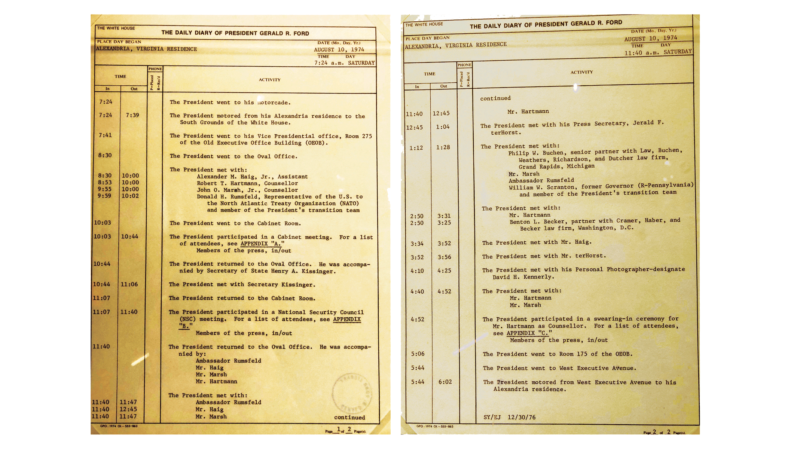
While in town, I visited the Gerald Ford Presidential Museum, a tribute to our 38th President. Before visiting the Museum, I didn’t know much about Ford, other than he was President on the day I was born.
Display after display detailed his younger years as a college football player, law student, and military officer. There were also numerous videos and artifacts from his time in office. Yet, one simple case mounted on the wall captivated me. It contained the detailed diary of Ford’s first day in office. Beyond offering an interesting glimpse into the daily life of the President, it offered insight into the working world of 1974. Ford’s first day in office took place at chaotic time. America was on edge with rising inflation, high unemployment, and a political scandal – Nixon had just resigned over Watergate. Bystanders at the time called it one of the “darkest hours” our nation faced. To say it was a stressful season, would be an understatement.
Yet, in the face of this turmoil, what did President Ford do on his very first morning in office? It was so routine for him that it didn’t even make the diary; instead, a sign next to the diary shared, “Ford began his first day as president in his usual manner. Following a morning swim, he gathered his newspaper and made his own breakfast.” The copy also conveyed that he left for work at 7:24 am and returned home at 5:44 pm.
How intriguing is that? You’re the leader of the free world, your country is in crisis, and yet you still make time to workout before heading to the office. And, you return home in time to have dinner with your family. What a time and energy management success story!
It seems like the working world of the 1970s was a bit wiser than the frenetic pace of today’s. While Ford was facing significant leadership challenges, he likely knew that doing too much and neglecting his health or time with his family would only set him up for failure.
A deeper look at Ford’s schedule also highlights additional best practices for productive work:
- Collaborate often, yet ensure meetings are focused. Note his 33 minute National Security Council meeting or his 41 minute Cabinet meeting. I bet there was a clear agenda and purpose before they assembled and when the meeting was done, it was adjourned.
- Spend one-on-one time with key team members. Ford met with four people individually on his first day in office. Building relationships is a priority for developing trust.
- Sometimes you must work through lunch. True story. But if you do, make sure dinner doesn’t suffer. Work can’t be a treadmill that goes on and on. To access the creativity and deep thought needed to solve complex challenges, if you’ve skipped a lunch break for productivity, be sure to head home on time to make up the deficit.
- Be intentional with your time. A well-planned day leads to productivity. An unplanned day leaves you susceptible to distraction and squandered time. At the end of your workday, create a list of 3-4 “must dos” before you head home. Then, when you arrive at work the next time, prioritize those few items amid the many tasks you’ll complete.
You could argue that Ford had the luxury of a staff to help him stay focused. While true, remember: he did make his own breakfast. He didn’t have all the luxuries! My point is simple: If a President can leave work on time, shouldn’t you be able, too?
PS Recent studies have shown that less … but better … can be a path to higher quality work product and performance. This past summer, Microsoft Japan tested a 4-day work week with employees. Results showed working less allowed employees to heighten focus and increase productivity by 40%. A German tech company, Rheingans Digital Enabler, tested (and has now adopted) a 5-hour workday after seeing productivity rise. Time is the only truly level playing field leaders have. Often the secret to leveraging it well, is recognizing that overwork diminishes productivity.
Join tens of thousands of subscribers who receive our free Leadership Moments – quick, actionable leadership guidance delivered to your inbox every Monday.




















